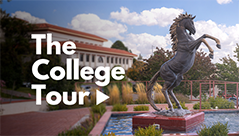Middle and high school students from across New Mexico gathered on the campus of Western New Mexico University this spring for National History Day.
National History Day is a nonprofit that aims to improve the study and appreciation of history among students. Its flagship event is a competition in which students across the country work within a broad national theme to research topics of interest to them and create a project. The type of project may be a paper, exhibit, performance, documentary or website, and students can choose to work either individually or in a small group.
In New Mexico, National History Day is sponsored by the New Mexico Humanities Council (NMHC). Each year, the event is held at a different venue around the state. According to the NMHC website, National History Day “aligns with the New Mexico state social studies standards that were implemented in 2023 and allows students to pursue their passions.”
At this year’s events, students all worked with the broad theme of “Rights and Responsibilities in History,” but the topics chosen by the different participants ranged greatly, from the impact of the Fair Labor Standards Act to the Indian Removal Act and the Trail of Tears.
The students participating came from as far as Los Alamos and as near as Silver City.
One local group in attendance represented Cobre High School. Cheyanne Medrano, Elias Guadiana and Mateo Salcido worked together to create a poster about the Tierra Amarilla Conflict, a key event in the Chicano land-rights movement.
The Tierra Amarilla Conflict, they explained, refers to an event in 1967 when Chicano activists stormed the Tierra Amarilla courthouse in northern New Mexico to protest how heirs of land grant holders under the Treaty of Guadalupe Hidalgo were dispossessed of their lands.
“We chose our topic because it is so local to us,” said Guadiana. “Some of us have had families that have gone through this.”
“Not a lot of people know these small stories about New Mexico,” said Salcido. “We thought it would be nice to tell a story that no one really knows about.”
Medrano, who has taken part in National History Day before, encouraged Guadiana and Salcido to join her this year. “We are all kind of history buffs,” explained Salcido. “So this allows us to learn something new, but we get to teach ourselves.”
The group agreed that the process leading to National History Day was nerve-wracking, but it was exciting to finally be at the event. “It is really gratifying seeing our work here and knowing that we are here to do what we came to do,” said Medrano
Stephanie Wilson, who directs National History Day for NMHC, said that success with this kind of independent project is exactly what the competition is about. “The purpose of National History Day is to create students who can think for themselves,” she said, “—students who can write a thesis statement, can come up with an argument, and can back that argument up with evidence.”
“We are hoping they can gain research skills,” she added. “One of the important skills [students develop] is determining if a source is valid or not, especially in today’s internet age.”
The kinds of skills that students learn from National History Day are the same ones that prepare them for college success, said Wilson. “It really does transform the students.”


